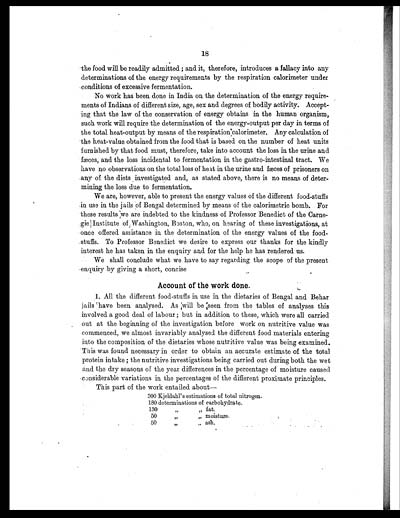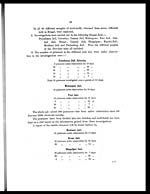Medicine - Institutions > Army health reports and medical documents > Scientific memoirs by officers of the Medical and Sanitary Departments of the Government of India > Number 37 - Investigations on Bengal jail dietaries > Front matter
(28) Page 18
Download files
Individual page:
Thumbnail gallery: Grid view | List view

18
the food will be readily admitted; and it, therefore, introduces a fallacy into any
determinations of the energy requirements by the respiration calorimeter under
conditions of excessive fermentation.
No work has been done in India on the determination of the energy require-
ments of Indians of different size, age, sex and degrees of bodily activity. Accept-
ing that the law of the conservation of energy obtains in the human organism,
such work will require the determination of the energy-output per day in terms of
the total heat-output by means of the respiration calorimeter. Any calculation of
the heat-value obtained from the food that is based on the number of heat units
furnished by that food must, therefore, take into account the loss in the urine and
fæces, and the loss incidental to fermentation in the gastro-intestinal tract. We
have no observations on the total loss of heat in the urine and fæces of prisoners on
any of the diets investigated and, as stated above, there is no means of deter-
mining the loss due to fermentation.
We are, however, able to present the energy values of the different food-stuffs
in use in the jails of Bengal determined by means of the calorimetric bomb. For
these results we are indebted to the kindness of Professor Benedict of the Carne-
gie Institute of Washington, Boston, who, on hearing of these investigations, at
once offered assistance in the determination of the energy values of the food-
stuffs. To Professor Benedict we desire to express our thanks for the kindly
interest he has taken in the enquiry and for the help he has rendered us.
We shall conclude what we have to say regarding the scope of the present
enquiry by giving a short, concise
Account of the work done.
1. All the different food-stuffs in use in the dietaries of Bengal and Behar
jails have been analysed. As will be seen from the tables of analyses this
involved a good deal of labour; but in addition to these, which were all carried
out at the beginning of the investigation before work on nutritive value was
commenced, we almost invariably analysed the different food materials entering
into the composition of the dietaries whose nutritive value was being examined.
This was found necessary in order to obtain an accurate estimate of the total
protein intake; the nutritive investigations being carried out during both the wet
and the dry seasons of the year differences in the percentage of moisture caused
considerable variations in the percentages of the different proximate principles.
This part of the work entailed about—
| 300 | Kjeldahl's estimations of total nitrogen. | ||
| 180 | determinations of carbohydrate. | ||
| 130 | " | " | fat. |
| 50 | " | " | moisture. |
| 50 | " | " | ash. |
Set display mode to: Large image | Zoom image | Transcription
Images and transcriptions on this page, including medium image downloads, may be used under the Creative Commons Attribution 4.0 International Licence unless otherwise stated. ![]()
| Permanent URL | https://digital.nls.uk/75032799 |
|---|




